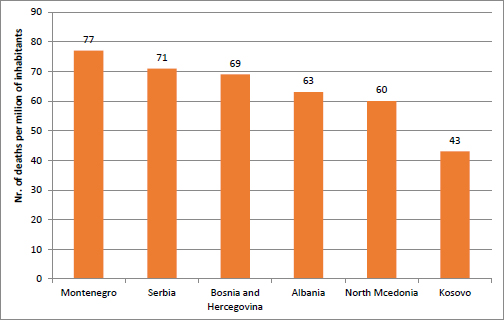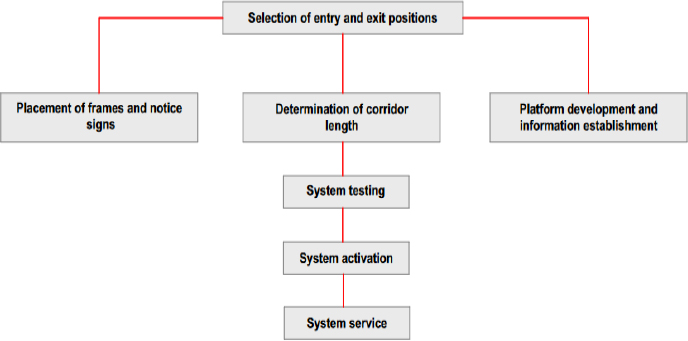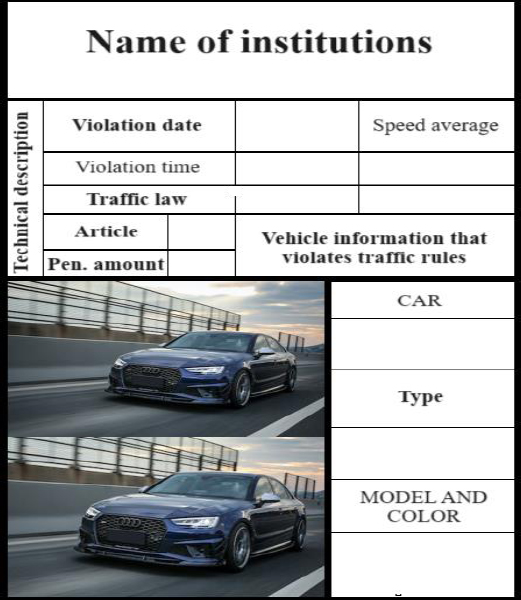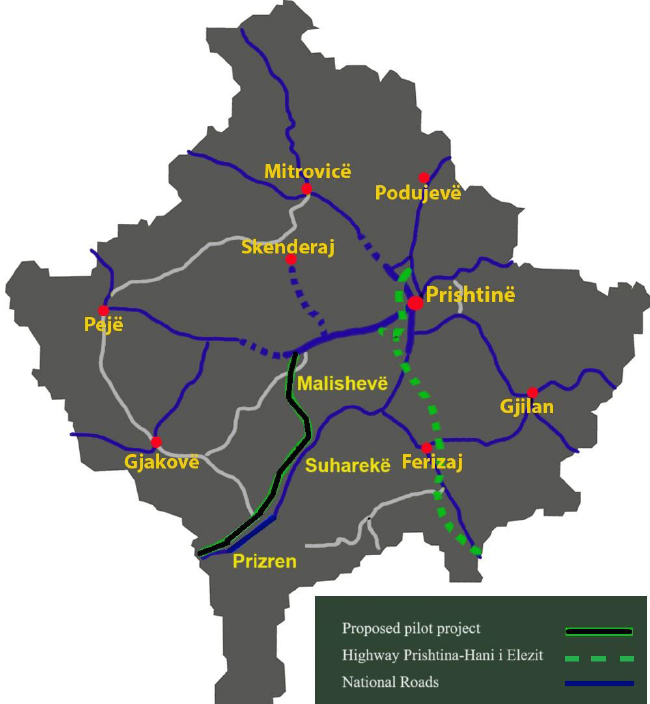All published articles of this journal are available on ScienceDirect.
Speed Corridor Enforcement System (SCES) - A Case Study of the Highways of Kosovo
Abstract
Background
Traffic safety remains a significant global concern. Despite advancements in vehicle technology, road infrastructure improvements, and initiatives to raise driver awareness, traffic accidents continue to pose socio-economic problems.
Objective
The aim of this study was to suggest the potential benefits of implementing a Speed Corridor Enforcement System on highways in Kosovo, aiming to reduce accidents and promote driver awareness.
Methods
To accomplish the stated objective, there is employed a scientific research methodology supported by surveys, statistics, and analysis methods. The sources of information comprise both primary and secondary data, which were gathered from scientific literature, online sources, and relevant studies in the field.
Results
The significant socio-economic challenges arising from traffic accidents are discussed, highlighting the necessity for a comprehensive and multidimensional approach to effectively address this issue. Additionally, the proposal of implementing Speed Control Enforcement Systems on the highways of Kosovo, which are part of Intelligent Transport Systems, is emphasized as a solution. Emphasis is placed on the importance of adopting advanced technological solutions alongside comprehensive strategies to effectively tackle the complex problem of traffic safety.
Conclusion
Considering the alarming 53.41% increase in accidents in Kosovo, the implementation of the speed identification system in corridors could have initially prevented and reduced accidents by a percentage similar to those observed in the reference countries.
1. INTRODUCTION
According to various studies, an average of 1.35 million people die in traffic accidents every year, and this death rate has remained relatively constant relative to the world's population size. In some countries around the world, there have been improvements, resulting in a reduction in the number of road traffic deaths in recent years. However, due to variations in measures and dedication, these improvements vary significantly among different countries. Economic and educational develop ment plays a crucial role in determining the level of accidents. The risk of death in road traffic is more than three times higher in countries with lower incomes compared to countries with higher incomes. The global average stands at 8.3 deaths per 100,000 inhabitants. In the case of Kosovo, the rate of deaths from road accidents per 100,000 inhabitants is lower than the global average, at 6.3 deaths [1]. The high number of traffic accidents resulting from exceeding the permitted speed in traffic places a significant responsibility on authorities and researchers. Finding solutions or instruments to eliminate or mitigate this phenomenon is essential to prevent potential accidents caused by speeding. In Kosovo, classical instruments with moving radar are currently utilized as a means to combat this issue despite ongoing initiatives for technological advancement. However, this method has limitations. Radar operations are time-bound and conducted at specific times and locations. This predictability becomes a drawback, as regular drivers often anticipate the presence of police radar at particular spots, diminishing the effectiveness of classic radar enforcement. When examining accident data based on time periods (season, month, day, week, day vs. night) and hours of the day (the first phase from 06:00 to 10:00, the second phase from 11:00 to 14:00, the third phase from 15 - 18, the fourth phase 19 - 22, the fifth phase 23 - 06) and considering accident locations (within settlements or outside of settlements), it becomes evident that classical radar's role does not cover a 24-hour cycle and the entire road network [2].
Therefore, there is a pressing need for research to identify more efficient instruments. This research should prioritize preventing misuse, especially in situations where classic radars are used, and consider continuous monitoring for all vehicles passing through a designated corridor. In the classification of the main causes of traffic accidents, it's important to note that accidents result from a multitude of factors. Statistical evaluations typically focus on the top two causes. In a study conducted in former West Germany, the leading cause was attributed to an inability to drive, while the second most common cause was speed mismatch (inadequate speed), accounting for 31.6% of accidents [3].
This observation is substantiated by recent research conducted in various countries. In Turkey, speeding has consistently emerged as one of the leading causes of accidents, particularly during the ten-year period spanning from 2010 to 2019. Examining the occurrence of fatal traffic accidents and injuries in light of this research, we find the following distribution: drivers account for 89.2%, pedestrians for 8.8%, passengers for 0.6%, road-related factors for 0.7%, and vehicle defects for 0.7%. Notably, human factors bear responsibility for a significant 98.6% of traffic accidents resulting in fatalities and injuries over the past decade, as evidenced by the data [4].
Speed Control Enforcement System (SCES), an application within the realm of Intelligent Transport Systems (ITS), has been developed to address the issue of traffic accidents caused by speeding. This system is increasingly being adopted worldwide with the goal of reducing accidents, improving road safety, and ensuring that drivers adhere to speed limits [5]. This paper will elucidate the role of SCES in identifying the average speed of a corridor and explore the feasibility of its implementation within a specific corridor, namely, the “Ibrahim Rugova” highway in the Prizren-Suharekë-Malishevë direction.
2. MATERIALS AND METHODS
This paper aims to enhance the literature on traffic safety by presenting the operational principles of corridor speed identification systems, which have gained widespread use in recent years. We cover the entire spectrum, from installation to commissioning, addressing crucial considerations. Our discussion draws from a comprehensive review of empirical studies on Speed Control Enforcement System. Additionally, we analyzed the factors influencing traffic accidents, emphasizing the urgent need for innovative speed management approa ches, particularly in preventing speed limit violations. Furthermore, we compared this system with the traditio nal radar approach for corridor speed measurement.
To accomplish the stated objective, we employed a scientific research methodology supported by surveys, statistics, and analysis methods. Our sources of information comprise both primary and secondary data, which were gathered from scientific literature, online sources, and relevant studies in the field (Fig. 1).
3. RESULTS
The rising use of personal cars for interurban transport in Kosovo presents a significant challenge. As of 2021, Kosovo had 397,935 registered motor and non-motor vehicles, representing an 11.4% increase compared to 2020 [6]. This trend has led to a greater emphasis on road construction (Table 1), which, in turn, has further fueled the proliferation of car usage and a corresponding increase in traffic accidents.
| Years | 2011 | 2012 | 2013 | 2014 | 2015 | 2016 | 2017 | 2018 | 2019 | 2020 | 2021 |
|---|---|---|---|---|---|---|---|---|---|---|---|
| Highway | 38 | 60.4 | 78 | 78 | 78 | 98 | 108 | 119.1 | 137.15 | 137.15 | 137.15 |
| National | 630.4 | 630.4 | 630.4 | 630.4 | 630.4 | 630.4 | 630.4 | 641.7 | 665.17 | 753.44 | 753.44 |
| Regional | 1294.7 | 1294.7 | 1294.7 | 1294.7 | 1305 | 1305 | 1305 | 1313.9 | 1471.24 | 1494.93 | 1494.93 |
| Local | 38.11 | 46.88 | 46.88 | ||||||||
| TOTAL | 1963.1 | 1985.5 | 2003.1 | 2003.1 | 2013.4 | 2033.4 | 2043.4 | 2074.7 | 2311.67 | 2432.4 | 2432.4 |

The stages of the work in this paper.
These developments have also resulted in an increase in accidents, although Kosovo has the lowest accident statistics when compared to other countries in the region. This can be observed in the statistics for 'Fatalities per million inhabitants in the Western Balkans 2020,' as shown in Fig. (2).

Overview of fatalities per million inhabitants in the Western Balkans, Year 2020 [8].
In a 2016 study in Kosovo, researchers provided the following statistics: out of 16,330 accidents, 68% occurred on straight roads, and approximately 25% were attributed to speeding [2]. Enhancing traffic safety and accident prevention, particularly through the development of pre ventive instruments, remains a significant responsibility of the Kosovo Police [9].
Intelligent Transport Systems (ITS) have been developed in many countries worldwide to prevent drivers from exceeding speed limits on urban and interurban roads. One such application is the Speed Control Enforcement System, which has gained popularity globally, especially in Europe and Australia [10].
In Kosovo, this system can be implemented on highways that meet the criteria for the Speed Control Enforcement System, such as those without level crossings. These systems can be placed at every entrance and exit of such highways. A practical test of this system can be conducted on a segment of the R7 Motorway, which is part of the Pan-European Corridor X and connects Kosovo with Albania. The R7 Motorway spans approximately 129.8 kilometers, with two lanes and an emergency lane in each direction, separated by a central reservation. It plays a vital role in economic and cultural connectivity between Kosovo and Albania, as well as within Kosovo itself, serving as a key transportation route (Fig. 3).
Classic radar is the primary equipment used in Kosovo to measure traffic speed on both urban and interurban roads. This system functions by transmitting an electromagnetic wave and detecting the reflected signal. Originally developed for detecting the presence and range of targets, radar earned its name as an acronym (RADAR) during World War II when it was used to identify approaching enemy aircraft and guide anti-aircraft guns. While modern radar systems have expanded their applications and can extract more information from reflected signals, accurate range finding remains a core function. There is currently no electronic system that can match radar's precision and efficiency in sensing and detection [11].
In 1940, the U.S. military developed a top-secret project known as 'Radio Detection and Ranging,' commonly known as Radar. Initially created to protect ships from aerial attacks and calculate distances for countermeasures, Radar has since found applications in various fields, including automotive technology. In cars, Radar is often combined with Sonar, which was originally used in submarines, because Radar waves can penetrate organic objects. However, Sonar has limitations when it comes to operating distances, and this gap is filled by remote imaging using laser technology [12].

Map of the road network in Kosovo (R6 and R7 Highways).
In areas with heavy traffic and a high frequency of accidents or speeding incidents, classic radar systems have proven less effective. Therefore, this study focuses on the Speed Control Enforcement System. The Netherlands was one of the pioneering European countries to implement Intelligent Transport Systems, including this application, following successful field trials in 1997 [13].
Unlike traditional radar, this system does not emit radar waves. Instead, it relies on advanced technologies, such as high-resolution cameras and mathematical algorithms, to record images of vehicles and calculate their speeds [14].
For instance, the Maarssen and Breukelen highways implemented this system at three locations along a specific section [10]. The system serves three primary objectives: (1) enhancing road safety, (2) improving traffic flow, and (3) automating the enforcement process. As a result, not only does this significantly reduce the workload of law enforcement, but it also accelerates the processing of automatic fines, with fine tickets being sent by mail [15].
The system's operation involves capturing a photo of the license plate upon entry into the corridor and matching this data with additional information obtained at subsequent camera locations upon exit. Automatic license plate recognition technology and optical character recognition are employed to match vehicle license plate information accurately [16].
The average speed detection system comprises several common components, as follows:
• Camera and lighting equipment
• Infrastructure elements (e.g., camera assembly, electrical wiring, clock device, power supply)
• Processors
• ANPR/OCR engine and associated software
• Network connectivity
• Central processing unit (back office) [10].
In European and Australian implementations of this system, designated locations at the entrance and exit of corridors (Fig. 4) typically feature cameras dedicated to monitoring specific traffic lanes within the application corridors. While this approach is common, it can sometimes lead to oversight, as a vehicle in one lane may momentarily obstruct the view of the camera monitoring the lane ahead. To address this, many systems also include cameras to monitor the adjacent lanes or sidebar [17].
The installation of this system requires careful consideration of various factors that can impact its operation, maintenance, and associated costs. These factors include the selection of the road, the distances between cameras, the number of cameras to be deployed, and the designated speed limits. Research studies recommend applying this system to road corridors longer than two kilometers [10].
The primary performance indicator for these systems is the average speed used to identify the corridor's overall speed. The formula for calculating the average speed is:
V av. = x / (t entry – t exit) ... (1) - Average speed
In the Netherlands, following the implementation of this system on a section of the A13 motorway in 2002, the total number of accidents decreased by 47%, and mortality decreased by 25%. Similarly, in the UK, there was a significant reduction of up to 65% in fatal and injury accidents and up to 20% in minor injury accidents [10]. In Ankara, the capital of Turkey, fatal accidents decreased by 29%, deaths by 35.9%, injuries by 15.2%, and overall traffic accidents by 1.8% [18] (Fig. 5).
A survey conducted in Australia, involving 315 regular drivers, revealed that 63% of respondents supported the implementation of the Speed Control Enforcement System [19].
With the implementation of this system, both direct and indirect benefits are expected due to its unique characteristics (Table 2).
Establishment of the Speed Control Enforcement System:
Below is a sample of the traffic penalty ticket report generated by the system in cases of exceeding the designated average speed for the respective corridor (Fig. 6).

Speed Control Enforcement System (SCES).

The System Development and Functionalization Algorithm [5].

The traffic penalty tickets generated by the system [20].
The automatically generated invoice produced by the system includes the following information:
• Offense detection point time and address details
• Type of offense
• Date and time of the offense
• Photos of the vehicle upon entry and exit from the corridor
• Calculated average speed of the vehicle
• Vehicle information (type, brand, color, model)
• Description of the offense (average speed limit and the extent of the speed violation)
• Total penalty amount
• Information about the operator responsible for processing the penalty form [10].
| 1 | Enhances road safety by ensuring that drivers adhere to speed limits along the corridor |
| 2 | In the corridors where it is installed, it reads license plates 24/7 and detects speed violations. It informs the security forces by identifying inappropriate actions (movement, carrying overloads, etc.) |
| 3 | The software's determinations allow for the identification of vehicles that continuously go to the corridor or pass many times in a short time. |
| 4 | Since license plate reading is done instantly, photos of all vehicles are instantly recorded, and thus, the vehicles required by security units can be automatically determined. |
| 5 | The system can perform vehicle counts and density measurements in the corridor where it is installed and it can provide data for traffic planning. |
| 6 | By increasing drivers' compliance with speed limits, it can reduce fuel consumption and accidents that may occur due to short-term acceleration or deceleration (acceleration). |
| 7 | It can reduce emissions and noise pollution by helping to regulate traffic flow (reducing speed differences). |
| 8 | In case of malfunction or intervention by unauthorized persons, the system can notify the control center. |
| 9 | Reducing the need for overtaking or pressure on the left lane. |
4. DISCUSSION
For the proposed pilot project in the designated corridor, we anticipate the following characteristics: multiple access points (entrance and exit). Starting from the south of Prizren, this corridor provides access to the center of Prizren and further extends into mountain roads, facilitating traffic towards North Macedonia. From the north of Prizren, it offers access to municipalities such as Rahovec, Gjakova, Deçan, Peja, Suharekë, Duhël, and Malishevë, ultimately connecting with Pristina [21] (Fig. 7).

Proposed pilot project in the designated Prizren-Malishevë corridor.
Annually, Kosovo registers over 397,935 vehicles, with approximately 80% of them being personal vehicles. As of 2021, Kosovo's road infrastructure consists of 2,432.40 kilometers, with 6% being highways, 31% national roads, 61% regional roads, and 2% local roads [6]. Along the 'Ibrahim Rugova' highway, the daily traffic volume exceeds 20,000 vehicles.
The proposed pilot project encompasses Prizren, including the surrounding municipalities of Rahovec and Gjakove, as well as Suhareka, Duhel, and Malisheve. Below, we present the population distribution within Kosovo based on divisions, regions, municipalities, and cities, including those municipalities incorporated into the study's pilot project (Table 3).
| Name | Region | Municipality | City |
|---|---|---|---|
| Prishitna | 476,192 | 198,214 | 145,149 |
| Prizren | 331,575 | 178,112 | 85,119 |
| Pejë | 172,602 | 95,723 | 48,962 |
| Ferizaj | 185,734 | 108,690 | 42,628 |
| Gjakovë | 194,273 | 94,000 | 40,827 |
| Mitrovica | 192,799 | 71,601 | 33,904 |
| Gjilani | 180,697 | 90,015 | 54,239 |
Comparing the classical radar system with the intelligent transport system reveals two distinct methods for measuring traffic speed: instantaneous speed, typically used with classical radar, and average speed, which the intelligent transport system calculates.
Unfortunately, due to institutional constraints, we were unable to access detailed statistics that would have included unit ticket counts in designated corridors, marking periods, peak ticket issuance times, camera locations, and the distances and characteristics between cameras. The available statistics from relevant institutions pertain solely to tickets issued for speeding under Law No. 05-L-088 for Road Traffic Rules. These statistics cover the “Dr. Ibrahim Rugova” highway, “Arben Xhaferi” highway, and the road segment between “Bresje” and “Gjurgicë” for the years 2022 and the period from January to May 2023 (Table 4).
The above (Table 4) suggests that the speed limits displayed on highways such as Ibrahim Rugova, Arben Xhaferi, and the Bresje-Gjurgjica road segment exceed the categories defined in Article 56, paragraph 4, by 20 km/h to 30 km/h. These speed limits are associated with approximately 80% of accidents. In essence, this implies that the classic radar system may be less effective in this category, potentially allowing drivers to exploit the situation.
To address this, measures should be implemented to encourage speed reduction before areas where the classic radar system is deployed. The speed identification system in the corridors can play a crucial role in eliminating these excesses, offering a substantial solution. This not only leads to a reduction in accidents but also indirectly educates drivers.
As a pilot project, this system should be installed in a single direction, covering the 'Ibrahim Rugova' highway's south entrance, north entrance and exit, and the entrances and exits of Suhareka, Duhel, and Malisheve. This segment encompasses the most densely populated region with 331,575 vehicles (including Prizren, Suhareke, Rahoveci, Malisheva, and Dragash) and serves as the busiest international corridor, connecting Kosovo and Albania (Republika e Kosovës, Ministria e Infrastrukturës, 2015).
| Period | Exceeding the Speed Limit | 2022 | January-May 2023 |
|---|---|---|---|
| Article 56 Paragraph 2 | Over (50) km/h | 1,221 | 410 |
| Article 56 Paragraph 3 | Over (30) km/h | 8,993 | 3,954 |
| Article 56 Paragraph 4 | (20) km/h to thirty (30) km/h | 39,050 | 17,075 |
| Article 56 Paragraph 5 | Over (10) km/h to twenty (20) km/h | 1,739 | 328 |
| Total | - | 51,003 | 21,767 |
CONCLUSION
Our research and reference works collectively serve as indicators of the efficiency of this system. It's important to note that research in this area is limited, and the available literature is relatively sparse.
Drawing from the benefits observed in reference countries, such as the Netherlands, where accidents decreased by 47%, and mortality by 25%; the United Kingdom, with reductions of up to 65% in fatal and injury accidents and up to 20% in minor injury accidents; and Ankara, Turkey, which experienced declines of 29% in fatal accidents, 35.9% in deaths, 15.2% in injuries, and 1.8% in overall traffic accidents, we can conclude that implementing the Speed Control Enforcement System can lead to an average reduction of around 30% in fatal accidents, while also indirectly contributing to driver education.
Considering the alarming 53.41% increase in accidents in Kosovo, the implementation of the speed identification system in corridors could have initially prevented and reduced accidents by a percentage similar to those observed in the reference countries.
Given that research indicates 68% of accidents occur on straight roads and about 25% are due to exceeding speed limits, this system can serve as a highly effective tool for reducing accidents, emphasizing the importance of adhering to permitted driving speeds.
The implementation of this system offers a multitude of benefits, not limited to:
• Improving road safety
• Providing continuous, detailed information to security institutions and beyond
• Offering valuable traffic data
• Promoting traffic education, especially regarding speed limit compliance.
During the initial phase of operationalizing the pilot project, which can be tested for several months, including the Prizren-Malishevë segment, Prizren the southern entrance, the northern entrance and exit, Suhareka entrances and exits, Duhel entrances and exits and Malishevë entrances and exits, we can take proactive measures to avoid system failures. After testing and identifying technical issues, with additional measures, the implementation of the system can be expanded to cover other corridors along the highways in Kosovo. Ultimately, the use of this system contributes to the advancement of traffic safety technology.
The technology not only serves the purpose of enhancing traffic safety but also enriches the archives of relevant institutions with detailed data, facilitating various planning and research endeavors. The implementation of the Speed Corridor Enforcement System (SCES) is imperative, as it has demonstrated its efficacy in numerous developed countries worldwide.
AUTHORS’ CONTRIBUTION
It is hereby acknowledged that all authors have accepted responsibility for the manuscript's content and consented to itssubmission. They have meticulously reviewed all results and unanimously approved the final version of the manuscript.


